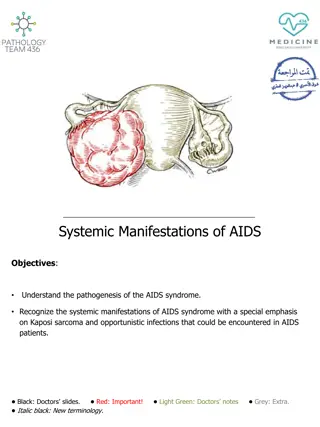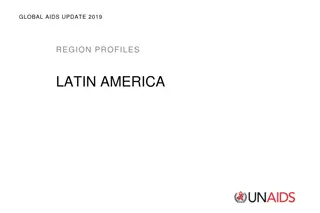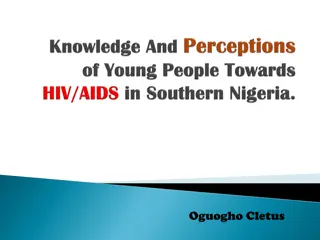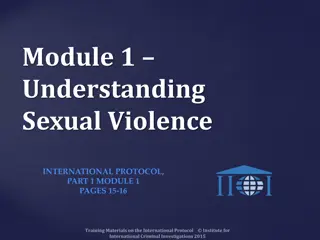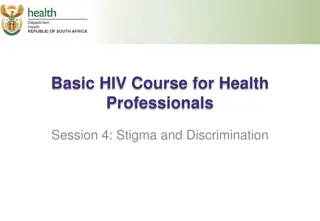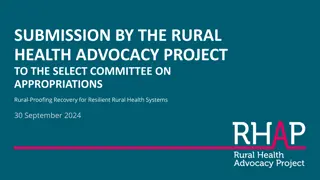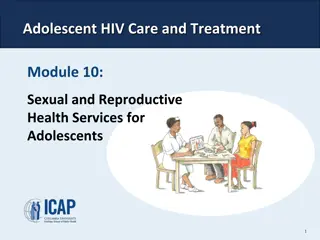Perceptions of Rural Women on Sexual Health Communication in HIV/AIDS Era
The research focuses on the perceptions of rural women in the Vhembe district, Limpopo province, regarding sexual health communication in the context of HIV/AIDS. It highlights the challenges women face due to gender norms, cultural practices, and societal inequalities that contribute to the vulnerability of women to HIV transmission. The study emphasizes the need for effective sexual health interventions to address these issues.
Download Presentation

Please find below an Image/Link to download the presentation.
The content on the website is provided AS IS for your information and personal use only. It may not be sold, licensed, or shared on other websites without obtaining consent from the author. Download presentation by click this link. If you encounter any issues during the download, it is possible that the publisher has removed the file from their server.
E N D
Presentation Transcript
Perceptions of rural women regarding sexual health communication in the era of HIV/AIDS in Vhembe district, Limpopo province: Implications for sexual health interventions Dr. RAMATHUBA DORAH URSULA UNIVERSITY OF VENDA, LIMPOPO PROVINCE SOUTH AFRICA 2nd International Conference on Nursing & Healthcare during November 17-19, 2014 at Chicago, USA.
Introduction HIV and AIDS continue to be one of the most challenging developmental issues in human history. In the early days of the epidemic, HIV was seen as a disease striking mainly men. Today, women account for nearly half of the 39.5 million people living with HIV worldwide. Of the 3.8 million new HIV infections that occurred among adults worldwide in 2006, 50 per cent were among women. In sub-Saharan Africa where HIV transmission is predominantly heterosexual, almost 60 percent of those infected are women. This dramatic rise in HIV prevalence among women is due to gender inequality and blatant human rights violations (Banerjee & Shama, 2007). Sub-Saharan Africa is the region worst-affected by HIV and AIDS. HIV/AIDS in South Africa is a prominent health concern; South Africa has the highest prevalence of HIV/AIDS compared to any other country in the world with 5,6 million people living with HIV, and 270,000 HIV related deaths recorded in 2011(WHO 2011). Structural factors influencing sexual health such as social, cultural, policies, and institutional practices that make certain populations vulnerable to disease may be stronger than one s personal desire to protect his/her health. Specifically, economic underdevelopment and gender inequalities have been identified as structural factors facilitating HIV transmission and are generalisable worldwide (Roberts, Oyun, Batnasan & Laing, 2005).
In each society, norms and beliefs of suitable roles for men and women are enforced by that society s institutions and practices, such as marriage, polygamy and female genital mutilation, among others. This determines the extent to which men and women are able to control the various aspects of their sexual lives, such as their ability to negotiate the timing of sex, conditions under which it takes place, and condom usage. Gendered socialization mainly produces inequality or inequitable gender norms between men and women. Such internalization can sometimes encourage behaviors that place women and their sexual partners at risk of various processes and styles of interaction in intimate relationships. Poor spousal communication may result from social and cultural norms that create an imbalanced relationship between the partners, one in which males are often in a more dominant position than their female counterparts. The AIDS and STI epidemic especially in South Africa and sub-Saharan African countries poses a huge challenge and has reached an alarming proportion (Lawoyin & Khanthula, 2010). Hence, focus on the unhealthy behavioral patterns between men and women in conjugal or other types of unions should be viewed from a risk perspective.
Problem Statement Social norms and cultural values set within patriarchal systems heighten women s vulnerabilities as they encourage silence around issues of sex and sexuality depriving them of the ability to say no to risky sexual practices. Girls are expected to be passive while boys are expected to be more active and display virility. In 2012 1234 women tested positive they only realized when they came for ante-natal clinic. The secrecy behind HIV/AIDS makes the situation worse because of confidentiality clause. In African culture and mostly rural areas where the study was undertaken, polygamy is a norm as well as arranged marriages for the widows by the family clan, in order to protect the wealth of the family and maintaining family lineage. Therefore the study explored how culture and gender affect sexual communication in the era of HIV.
Research design and method A qualitative, explorative, descriptive and contextual research design was used. A qualitative research approach was chosen to understand, interpret, and describe the perceptions of rural women regarding sexual health communication (Creswell, 2009). The population comprised of women residing in Thulamela municipality in Vhembe district of Limpopo Province. A non- probability, convenience sampling method was used . Twenty five females and only eight were single while the rest were married. Data were collected through in-depth individual interviews with seven women and two focus group discussions. The central question that directed the research study during these sessions were Can you please explain how culture and gender influences communication relating to sexual health . Probing questions were asked to allow for deeper and more thoughtful responses from informants (Rubin & Rubin, 2005). Data sets were analysed using Tesch s eight steps of open coding in which raw data was organised into five categories (Creswell, 2009). Guba s model of trustworthiness criteria, namely, credibility, transferability, dependability and confirmability (Lincoln and Guba (1985), The interviews were conducted in naturalistic setting Krefting (1991) within the context of a health care facility. The researcher obtained valued information through prolonged participation without allowing bias or own perspectives to influence the conversation.
Findings THEMES CATEGORIES Power dynamics Male identity and sexual health Level of sexual health education and condom use and sexual health Marital status and sexual health communication Socio cultural factors Economic vulnerability and sexual health Poor access to treatment of STI s, stigma, blame and sexual health
Quotes Male identity and sexual health Another participant stated the problem is as a women it s a sign of disrespect or being unruly to deny your partner sex, you are even told by the elders that culturally it is no longer your body so for peace sake, you are bound to give in because he starts being angry, and you give in for fear of instigating violence in a relationship . Furthermore another participant indicated that: Most men are not interested in negotiating sex, they just force themselves to you, they will continue to fondle or try to undress and you cannot say no because is your partner, and you are not included in sexual decision-making . Level of sexual education and sexual health communication One participant indicated that: most men are not not using a condom as it reduces their sexual pleasure and that they did not belief that their primary partner in the home situation can place them at risk because culturally women are supposed to be submissive, show passivity when it comes to sex, because if you show sign that you are enlightened with sexual issues you are called names such as dabadaba (implying that you are of loose morals). Another participant said: If I ask my husband to use a condom, he will scold me and ask me whether I still trust him or not and it, so it is not a subject to talk directly, and you cannot complain to anyone because culturally (munna ndi mbado) literally meaning that men are there to be shared .
Marital status and sexual health communication One participant indicated that she suspects that her husband is cheating because she feels itchy in the private parts and is having a discharge, but it is so difficult to confront the issue, you just beat about the bush and generalize the subject to say people will die, it s dangerous outside as HIV/AIDS is all over . Another participant said It is a known fact that men cheat, sometimes women are told about children they support outside marriage, and women should just accept the situation . Negotiating safe sexual practices and insisting on partner fidelity becomes further complicated in polygamous households given that multiple wives are often reliant on one husband for material survival (Banerjee & Shama, 2007). Economic vulnerability, stigma and sexual health communication Participant indicated that one woman found out that she is infected and it is difficult to disclose her status to her family because in the community it s like you are contagious, people no longer want to associate with you . This exemplifies negative reactions to disclosure and women often suffer in silence. Furthermore, participant stated that the woman indicated that if she can disclose, she fears being rejected or the husband leaving him as she has no other form of support and moreover when you have HIV you are taken as a women who sleeps around
Bearing the blame of sexually transmitted infections resulting from multiple partners There is often a common assumption or stereotype amongst the Vha-Venda inferring that when a person suffers from a sexually transmitted infectious disease, that they are malwadze a vhasadi - implying that this is a women s disease. One participant indicated When your partner starts showing signs of STIs or HIV, they start spreading rumours that she slept with a woman who aborted, indicating that o wela implying that he got the infection from a woman, all the blame will rest on you, whilst knowing that you have been faithful all along. Another participant had this to say Yoh, everybody will be told that you have dripping vaginal discharge and you will kill your baby if you have a toddler Accessibility to STI treatment, blame and hopelessness and sexual health communication Women around the world find themselves under conditions of poverty. The participant indicated that It s so difficult to get proper treatment at the clinic, sometimes there are no medicines, and you don t have money to buy from chemist, and you rely on the husband, he will not give you money to go to private doctor, it expensive Another one said we are not educated, if you were educated, one will be having money and you can go to private
Women with STIs have been viewed as tainted, and as vectors of disease who pass their infections on to men. One participant indicated What is the use of disclosing your sexual health problem or your status when you know that all the blame will rest on you, whilst knowing that you have been faithful all along. Findings by East et al. (2011) revealed that young women diagnosed with human papillomavirus (HPV) expressed concerns about being stigmatized and feared rejection from others, due to the societal view that STIs are associated with dirty promiscuous individuals. Similar outcomes were reported by (Kahn et al., 2007), who suggested that women with a positive HPV diagnosis experienced anxiety, shame and stigma, leading to negative views and feelings towards their own sexual relationships.
Discussions The study indicated that the level of sexual communication and knowledge regarding HIV and STI prevention was inadequate. Socio-economic conditions also places women in a vulnerable situation, by not having means of support affects the health behaviours of women as they will just conform to unsafe sexual practices and also suffer in silence by not seeking medical treatment as they feared stigmatization and humiliation of having a sexually transmitted infection. Communication regarding healthy sexual practices was mostly not occurring; participants were women of the same ethnic group and often bound by cultural norms within the Vha-Venda. It is considered difficult to change the social norm of conforming to your husband due to the need to respect for the head of your household. Even though the effectiveness of condoms for the prevention of HIV has been proven and propagated throughout Africa, cultural barriers deter its active use. Women generally find it difficult to negotiate condom use with their long-term partners, because even the suggestion of using it might be seen as an accusation of the partner s infidelity or an admission of adultery on the part of the woman herself, which could provoke violence (Burgoyne & Drummond, 2008; Mash, Mash & Villiers, 2010). Directly challenging the spouse about infidelity risks an argument, which both spouses try to avoid because persistent arguments are not compatible with a good marriage. A formal recognition of polygamous unions in various countries amounts to reinforcement of the patriarchal notion that women should passively accept their partners sexual decision making.
Economic dependency and less education places women at risk however working women have a greater tendency towards equitable gender norms compared to their non-working counterparts.- most unemployed women were dependent on the family household for support- sexual health was not a priority. Women who had STIs were held responsible for the disease and became scapegoats, especially when there is fast feminization of HIV, and the risky sexual behaviors of young women such as sugar-daddy relationships is believed to be a major factor in the spread of the disease. Older men in Vha-Venda culture deny having loss of libido and sexual drive and they end up having sexual relationships with young girls, and poverty drives these young girls into risky sexual practices. Early and prompt treatment of partners is failing most of the time because of a complicated sexual networks of men, as some women will not be known within the family household. Men are usually not included in the reproductive health service amongst black communities, there s a myth that clinics are for children and mothers
Recommendations HIV programs must address the root causes of gender-based vulnerability to HIV such as socio-economic status, culture and religion. HIV programs must focus on greater sensitization and education of men and women on the traditions and cultural practices that increase the risk of HIV infection, such as the disadvantages of polygamous or having extra sexual networks. Men are critical role-players to be included in reproductive health, being effectively counseled on correct condom use and the need to remain faithful to their partners. Partners are encouraged to break gender stereotypes and relate to each other as equals, to develop self-esteem and to strengthen their abilities to problem solving, make decisions and manage interpersonal relations. Discourage social labeling and stigmatization of the sexually transmitted infections with partners supporting each other in treatment regimen.
Conclusions The study explored culture and gendered communication relating to sexual health. Gender stereotypes and social misconceptions of manhood needs to be reviewed as it has a profound impact on sexually transmitted infections. Men need to be co-opted into reproductive health programmes so that they are able to protect their own health and those of women and children. Women need to be empowered to negotiate safe sex practices and to communicate their aspirations and expectations in a frank and assertive manner.







